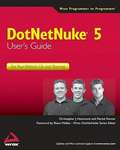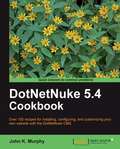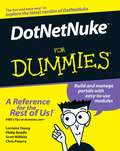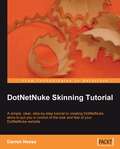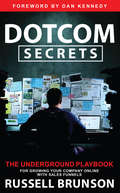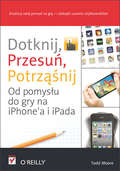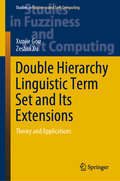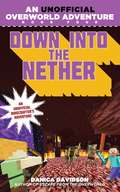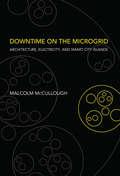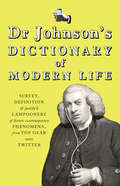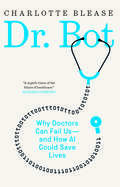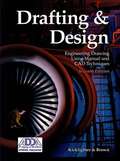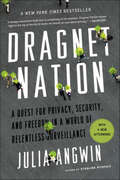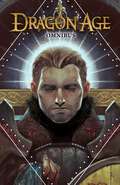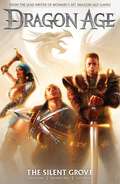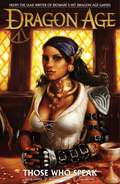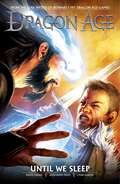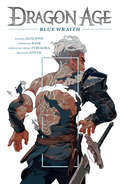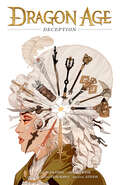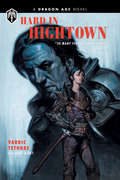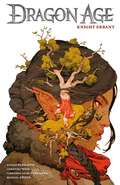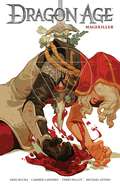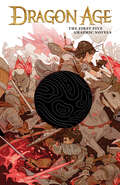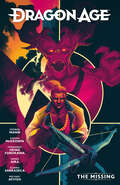- Table View
- List View
DotNetNuke 5 User's Guide
by Shaun Walker Patrick Renner Christopher J. HammondAn authoritative introduction to implementing DotNetNuke Web sites, by experienced DotNetNuke implementers and trainersAn impressive author team shows you how to easily build Web sites with a variety of content features - no programming experience required.If your goal is to build the site without worrying about the programming behind it, DotNetNuke 5 User's Guide gives you exactly what you need. After developing a groundwork in the DotNetNuke framework and DotNetNuke as a content management system, it provides installation and administration information. Then it takes you step by step through a variety of use cases, implementation strategies, and configuration decisions for various sites.Introduces the benefits of content management systems, open source, how DotNetNuke functions as a content management system, and DotNetNuke modules, pages, and skinsExplains the installation process, options for installing DotNetNuke, and requirements, as well as administration functionality and content management fundamentals for DNN sitesExamines different use cases, implementation strategies, and configuration decisionsShows how to develop and implement a personal Web site, a team or club community, a small business site, and an enterprise solutionLooks at various advanced topics relevant to all use cases, ranging from advanced installation options to detailed administrative featuresIncludes a foreword by Shaun Walker, creator of DotNetNuke and Wrox DotnetNuke series editorDotNetNuke 5 User's Guide provides the tools you need to put this valuable technology to work.
DotNetNuke 5.4 Cookbook
by John K MurphyThis is a cookbook: each chapter contains a selection of useful self-contained recipes. The book begins with simple recipes for installing and configuring DotNetNuke then offers recipes for using out-of-the-box modules before delving into custom module and skin development. If you are a .NET developer with beginner to intermediate knowledge of Visual Basic or C# and want to develop a website/CMS using DotNetNuke, this book is for you. Familiarity with DNN operation, CSS, and basic web development (ASP.NET) skills is required.
DotNetNuke For Dummies
by Lorraine Young Philip Beadle Scott Willhite Chris PaterraDo you want to develop Web sites without the help of a programmer? Lucky for you there's DotNetNuke, a content management system that allows you to build and maintain dynamic Web sites just by using a Web browser. DotNetNuke For Dummies helps you get down to business and shows you how to create a user-friendly Web site. You'll find out how you can build and manage a flexible, versatile site with all the advantages an open-source application offers, use convenient modules, build a community, and save some money at the same time. This plain-English guide lets you discover how to: Install, run, and troubleshoot DotNetNuke Change and customize portal settings Add and manage pages on your site Make your site look professional Deliver contents with Text/HTML Add news feeds, online surveys, and banners Interact with visitors through blogging, feedback comments, and forums Create an e-business Customize the look of your site with exciting components This book features cool new modules that will meet every Web site's need, both commercial and personal. With DotNetNuke For Dummies, you'll get up to speed with this wonderful online tool and create your own corner of the World Wide Web!
DotNetNuke Skinning Tutorial
by Darren NeeseDesigned as a tutorial for beginners to DotNetNuke skinning, this book is packed with practical steps for you to try. Written in a clear, easy-to-read style this book will guide you through the most important tasks of working with DotNetNuke skins. This book is for web designers or developers who want to customize DNN sites, to bring a specific look and feel to them, and create more attractive user interfaces. This book is ideal for beginners to DotNetNuke skinning. You will need to know about the general operation of DotNetNuke and also have some familiarity with creating web pages. Familiarity with CSS and basic ASP.NET would be a bonus.
Dotcom Secrets: The Underground Playbook for Growing Your Company Online with Sales Funnels
by Russell BrunsonMaster the science of funnel building to grow your company online with sales funnels in this updated edition from the $100M entrepreneur and co-founder of the software company ClickFunnels.DotCom Secrets is not just another "how-to" book on internet marketing. This book is not about getting more traffic to your website--yet the secrets you'll learn will help you to get exponentially more traffic than ever before.This book is not about increasing your conversions--yet these secrets will increase your conversions more than any headline tweak or split test you could ever hope to make.Low traffic or low conversion rates are symptoms of a much greater problem that's a little harder to see (that's the bad news), but a lot easier to fix (that's the good news).What most businesses really have is a "funnel" problem. Your funnel is the online process that you take your potential customers through to turn them into actual customers. Everyone has a funnel (even if they don't realize it), and yours is either bringing more customers to you, or repelling them.In this updated edition, Russell Brunson, CEO and co-founder of the multimillion-dollar software company ClickFunnels, reveals his greatest secrets to generating leads and selling products and services after running tens of thousands of his own split tests.Stop repelling potential customers. Implement these processes, funnels, frameworks, and scripts now so you can fix your funnel, turn it into the most profitable member of your team, and grow your company online.
Dotknij, przesu?, potrz??nij. Od pomys?u do gry na iPhone'a i iPada
by Todd MooreZrealizuj swój pomys? na gr? i odnie? sukces!Nawet je?li rynek gier i aplikacji mobilnych nie prze?cignš? jeszcze rynku tych produktów dla komputerów osobistych, to wkrótce to zrobi. Miliony u?ytkowników, przyst?pne ceny oraz powszechny dost?p do ekranów dotykowych, GPS i internetu — wszystko to sprawia, ?e gry na iPhone’a czy iPada sš cz?sto o wiele bardziej atrakcyjne ni? ich odpowiedniki przeznaczone na zwyk?e komputery. Najwa?niejszy jest pomys? na gr?. Musi by? nowatorski, atrakcyjny i wcišgajšcy. Je?li ju? go masz, ten przewodnik poka?e Ci, w jaki sposób przej?? do utworzenia prawdziwej i-aplikacji. Przedstawiony proces konstruowania rzeczywistej gry pozwoli Ci zdoby? podstawy dotyczšce narz?dzia Xcode i j?zyka Objective-C. Jednocze?nie nauczysz si?, jak implementowa? logik? gry, przygotowywa? grafik? i efekty d?wi?kowe, a tak?e opracowa? sztucznš inteligencj? dla gracza-komputera. Ju? wkrótce mo?esz zdoby? s?aw? i czerpa? z tego wymierne korzy?ci! Z tš ksiš?kš w r?ku ka?dy programista zamieni pomys? na rzeczywisty produkt, gotowy do rozpowszechniania w sklepie iTunes App Store.Zacznij od prostej gry, wymagajšcej utworzenia jedynie oko?o dwudziestu wierszy koduZbuduj ca?kowicie od poczštku gr? w hokeja na stolePoznaj najlepsze praktyki w zakresie ?ledzenia wielu dotyków na ekranieStwórz animacj? i przygotuj funkcje wykrywania kolizjiWykorzystaj niezb?dne narz?dzia do przygotowania atrakcyjnej grafiki dla gryDopracuj fizyk? w grze, aby nada? jej wi?kszy realizmNagraj i przeprowad? edycj? efektów d?wi?kowych oraz utwórz w?asnš muzyk? odtwarzanš w tleZaprojektuj gracza-komputer, grajšcego na ró?nych poziomach trudno?ciZamie? pomys? na produkt gotowy do rozpowszechniania w sklepie iTunes App Store!Todd Moore za?o?y? firm? TMSOFT, by konstruowa? wyjštkowe aplikacje i gry przeznaczone dla smartfonów. Stworzona przez niego popularna gra Card Counter zosta?a wyró?niona przez Engadget, "Los Angeles Times" oraz CNET TV. Najpopularniejsza aplikacja Todda — White Noise — zdoby?a uznanie iTunes App Store, "Health Magazine", "Washington Post", "PC Magazine" i Late Night with Jimmy Fallon.
Double Hierarchy Linguistic Term Set and Its Extensions: Theory and Applications (Studies in Fuzziness and Soft Computing #396)
by Zeshui Xu Xunjie GouThis book presents the concept of the double hierarchy linguistic term set and its extensions, which can deal with dynamic and complex decision-making problems. With the rapid development of science and technology and the acceleration of information updating, the complexity of decision-making problems has become increasingly obvious. This book provides a comprehensive and systematic introduction to the latest research in the field, including measurement methods, consistency methods, group consensus and large-scale group consensus decision-making methods, as well as their practical applications. Intended for engineers, technicians, and researchers in the fields of computer linguistics, operations research, information science, management science and engineering, it also serves as a textbook for postgraduate and senior undergraduate university students.
Down into the Nether: An Unofficial Overworld Adventure, Book Four (Unofficial Overworld Adventure)
by Danica DavidsonStevie and Alex thought they defeated Herobrine completely, but they soon discover that he’s still on the loose. He has returned to Stevie’s nightmares, taunting him with threats to now destroy the human world.The prophecies on music discs suggest that only Stevie and Alex, plus Maison, Destiny and Yancy, their friends from the human world will be able to defeat Herobrine. But the prophecies also warn that one of the friends will betray the rest, putting all the worlds at risk. Tensions run high as the group must figure out how to save the world while they try to discern the traitor in their midst. Maison, It isn’t long before the traitor is discovered.Stevie and Alex find themselves separated from the others and must first journey into the Nether to find a special treasure that will enable them to confront Herobrine. The clock is ticking as they put their heads together to survive in the fiery depths of the Nether. Monsters are waiting for them around every corner and it won’t be much longer before they come face-to-face with Herobrine, who has become more powerful than ever.Sky Pony Press, with our Good Books, Racehorse and Arcade imprints, is proud to publish a broad range of books for young readers-picture books for small children, chapter books, books for middle grade readers, and novels for young adults. Our list includes bestsellers for children who love to play Minecraft; stories told with LEGO bricks; books that teach lessons about tolerance, patience, and the environment, and much more. While not every title we publish becomes a New York Times bestseller or a national bestseller, we are committed to books on subjects that are sometimes overlooked and to authors whose work might not otherwise find a home.
Downtime on the Microgrid: Architecture, Electricity, and Smart City Islands (Infrastructures)
by Malcolm McCulloughSomething good about the smart city: a human-centered account of why the future of electricity is local.Resilience now matters most, and most resilience is local—even for that most universal, foundational modern resource: the electric power grid. Today that technological marvel is changing more rapidly than it has for a lifetime, and in our new grid awareness, community microgrids have become a fascinating catalyst for cultural value change. In Downtime on the Microgrid, Malcolm McCullough offers a thoughtful counterpoint to the cascade of white papers on smart clean infrastructure. Writing from an experiential perspective, McCullough avoids the usual smart city futurism, technological solutionism, policy acronyms, green idealism, critical theory jargon, and doomsday prepping to provide new cultural context for a subject long a favorite theme in science and technology studies. McCullough describes the three eras of North American electrification: innovation, consolidation, and decentralization. He considers the microgrid boom and its relevance to the built environment as “architecture's grid edge.” Finally, he argues that resilience arises from clusters; although a microgrid is often described as an island, future resilience will require archipelagos—clusters of microgrids, with a two-way, intermittent connectiveness that is very different from the always-on, top-down technofuture we may be expecting. With Downtime on the Microgrid, McCullough rises above techno-hype to find something good about the smart city and reassuring about local resilience.
Dr Johnson's Dictionary of Modern Life: Survey, Definition & justify'd Lampoonery of divers contemporary Phenomena, from Top Gear unto Twitter
by Dr JohnsonIn 2009 Dr Samuel Johnson made a surprise re-emergence from eighteenth century retirement and began Twittering. It proved the perfect vehicle for his acerbic, aphoristic wit and he has quickly become the darling of the site. The Guardian calls him the 'greatest' thing on Twitter and the Telegraph dubs him its 'star'.Our gouty man of letters finds the modern world in a parlous state. It is peopled with fools like "Raisin-ey'd Tyrant Mister Nick GRIFFIN" and "BABOON-SLAYER, Fop, Macaroni, Dandy & Folderol, Mister AA Gill". His attempts to negotiate a path through the vagaries of modern life do not fare well either - for instance, on a trip to "Mister LIBERTY'S blast'd Haberdashery", upon finding "all else clad as Lumber-Jacks, I left thwart'd & alone... unwilling to dress as an unmanly Pastiche of Mister COBAIN." In his Dictionary of Modern Life, our gouty man of letters takes a wickedly funny look at all things modern. From Top Gear and the Daily Mail to Dubstep and Celebrity Big Brother, nothing escapes his sardonic gaze.
Dr. Bot: Why Doctors Can Fail Us—and How AI Could Save Lives
by Charlotte BleaseHow does AI compare to a doctor when it comes to saving lives? Doctors are under-resourced and face unprecedented levels of stress, with rising patient numbers and ever developing medical knowledge. But at the same time, they are all too human, prone to racial, class and social biases that affect the care patients receive. Can we improve patient experience and alleviate the burdens of doctors at the same time? In this groundbreaking study, Charlotte Blease reveals how AI, if handled with care, could emerge as the most reliable physician in history. Drawing on interviews with authorities in AI, doctors and patients, Blease shows how technology – despite some resistance – is already making a difference. From diagnosis and second opinions to treatment and aftercare, AI has the potential to revolutionise our healthcare.
Drafting & Design: Engineering Drawing Using Manual and CAD Techniques
by Clois E. Kicklighter Walter C. BrownNIMAC-sourced textbook
Drafting and Design: Engineering Drawing Using Manual and CAD Techniques
by Clois E. Kicklighter Walter C. BrownWritten to meet the educational needs of both beginning and advanced students, Drafting & Design features comprehensive instruction in both manual (traditional) drafting and computer-aided drafting (CAD). Step-by-step, detailed drafting procedures are presented throughout the text to illustrate the tools and techniques of both methods. For each drafting task presented, manual and CAD procedures are given in sequence to explain both approaches to drafting.
Dragnet Nation: A Quest for Privacy, Security, and Freedom in a World of Relentless Surveillance
by Julia AngwinAn inside look at who's watching you, what they know and why it matters. We are being watched.We see online ads from websites we've visited, long after we've moved on to other interests. Our smartphones and cars transmit our location, enabling us to know what's in the neighborhood but also enabling others to track us. And the federal government, we recently learned, has been conducting a massive data-gathering surveillance operation across the Internet and on our phone lines.In Dragnet Nation, award-winning investigative journalist Julia Angwin reports from the front lines of America's surveillance economy, offering a revelatory and unsettling look at how the government, private companies, and even criminals use technology to indiscriminately sweep up vast amounts of our personal data. In a world where we can be watched in our own homes, where we can no longer keep secrets, and where we can be impersonated, financially manipulated, or even placed in a police lineup, Angwin argues that the greatest long-term danger is that we start to internalize the surveillance and censor our words and thoughts, until we lose the very freedom that makes us unique individuals. Appalled at such a prospect, Angwin conducts a series of experiments to try to protect herself, ranging from quitting Google to carrying a "burner" phone, showing how difficult it is for an average citizen to resist the dragnets' reach.Her book is a cautionary tale for all of us, with profound implications for our values, our society, and our very selves.
Dragon Age Omnibus
by VariousBioWare&’s best-selling franchise Dragon Age lives on in these canonical comics from Dark Horse—now in an affordable omnibus format! Dragon Age lead writer David Gaider pens an exciting tale following King Alistair as he discovers the fate of his father. Collects Dragon Age miniseries The Silent Grove, Those Who Speak, and Until We Sleep. * Written by Dragon Age lead writer David Gaider! * Now available in an affordable paperback omnibus!
Dragon Age Volume 1: The Silent Grove (Dragon Age)
by David GaiderDragon Age: The Silent Grove is the perfect introduction to BioWare's dark fantasy universe! In this essential, canonical story from David Gaider, lead writer of the games, King Alistair, accompanied only by rogues Isabela and Varric, embarks on a quest deep inside the borders of Antiva—a nation of assassins! Together, they will encounter a prison break, dragons, the mysterious Witch of the Wilds, and one of the greatest secrets in the history of the world!* Story by David Gaider, lead writer of the Dragon Age games and novels!* Collecting Dragon Age #1–#6!
Dragon Age Volume 2: Those Who Speak (Dragon Age)
by David GaiderDragon Age Lead Writer David Gaider brings his newest epic to a revealing conclusion! With her dark past laid bare, the pirate Isabela must resolve to escape this dungeon or lose herself forever, even as King Alistair must take up arms against an old ally if he is to have any hope of uncovering the fate of his father! * Story by David Gaider, lead writer of Dragon Age: Origins and Dragon Age II!
Dragon Age Volume 3: Until We Sleep (Dragon Age)
by David GaiderThe lead writer of BioWare's hit Dragon Age games concludes King Alistair's epic quest—in a journey beyond reality itself! Fans around the world have recognized the Dragon Age comics to be an integral addition to the video-game saga. Now, series writer David Gaider pits King Alistair and his noble companions Varric and Isabela against their most nefarious foe—the twisted blood mage Aurelian Titus! An essential read while you wait for Dragon Age III! from Dragon Age lead writer DAVID GAIDER!
Dragon Age: Blue Wraith
by Christina Weir Nunzio DeFilippisA group of Inquisition agents pursue the deadly elven warrior Fenris in this new chapter from the world of BioWare's dark fantasy RPG!From the video game developer of genre-defining roleplaying games such as Baldur's Gate, Star Wars: Knights of the Old Republic, and Mass Effect comes a canonical continuation of stories begun in the multiple game of the year award-winning Dragon Age: Inquisition.The power of the substance known as red lyrium is as dark as it is devastating, and a mysterious weapon containing a frightening amount of it is about to fall into the wrong hands. Enter knight Ser Aaron Hawthorne, elven thief Vaea, the magekillers Tessa Forsythia and Marius, and fledgling con artist Calix Pryde--a motley team of Inquisition agents whose task it is to recover the lyrium artifact before it's too late. In order to do so, fellow agent Varric Tethras directs them to recruit one more to their party, a former associate from Kirkwall--Fenris. However, as the team quickly discovers, this legendary fighter has an agenda of his own, and convincing him to join their cause will be no small feat.Collects Dragon Age: Blue Wraith #1-#3.
Dragon Age: Deception
by Christina Weir Nunzio DeFilippisBioWare's bestselling fantasy franchise lives on in these canonical comics from Dark Horse!Olivia Pryde hasn't worked an honest day in years. Once an actress, she now lives by the con, and has come to Tevinter with a new target: Calix Qintara, the heir to a wealthy house. Once she approaches the young man, she quickly realizes that he is not exactly who he says he is--and she may be in too deep. This version collects Dragon Age: Deception #1-#3.
Dragon Age: Hard in Hightown
by Various Varric Tethras Mary KirbyProlific dwarven author and heroic companion of the Dragon Age games, Varric Tethras brings us the collected edition of his breakthrough crime-noir drama, Hard in Hightown (with help from his trusted human confidante, Mary Kirby)! This volume is beautifully illustrated by Stefano Martino, Álvaro Sarraseca, Andres Ponce, and Ricardo German Ponce Torres, with a painted cover by E.M. Gist!Twenty years of patrols have chiseled each and every stone of the Kirkwall streets into city guardsmen Donnen Brennokovic. Weary and weathered, Donnen is paired with a recruit so green he might as well have leaves growing out of his armor. When the mismatched pair discover a dead magistrate bleeding out on the flagstones, they're caught up in a clash between a shadowy organization known only as the Executors and a secretive group of Chantry agents--all over some ancient artifact.This is a prose novel featuring 24 black And white full page images.
Dragon Age: Knight Errant
by Christina Weir Nunzio DeFilippisBioWare's bestselling fantasy franchise, Dragon Age, lives on in these canonical comics from Dark Horse!Vaea, an elven squire, and her knight, the drunken Ser Aaron Hawthorne, arrive in Kirkwall just in time for Varric Tethras' appointment as Viscount. A talented thief, Vaea skips the party to take on an easy job recovering a hidden lock box . . . but when she chooses to change the terms of the deal mid-heist, she is entangled in a dangerous mission that is surely above her pay grade.Collects the comic series Dragon Age: Knight Errant, Issues #1-5
Dragon Age: Magekiller
by Various&“Dragon Age: Magekiller is a fun and engaging fantasy story for anyone who enjoys the genre.&”—Comic Book ResourcesTessa and Marius are mercenary partners who eliminate those that use magic to hurt others. When they betray a powerful patron intending to kill them, they&’re forced to flee and join the Inquisition. Collects issues #1–#5 of the miniseries.
Dragon Age: The First Five Graphic Novels
by Greg Rucka Christina Weir Alexander Freed David Gaider Nunzio DeFilippisIn Bioware's dark fantasy world of Thedas there are those who are willing to sacrifice their humanity for wealth and power, and those who will die to protect innocent people from them.The heroes of Thedas are often from unlikely places, some are pulled in to save the day by an odd string of fate, others seek adventure out on their own. These are their stories. The lonely king Alistair seeks out his father who was "lost at sea" fifteen years prior, but now he has a reason to think the old king is still alive. With the help of his friends, Varric the silver tongued Dwarven rogue and Isabella the legendary pirate, Alistair just may find out what happened to his father. The small party will face down assassins, dragons, Qunari elites, corrupted mages and more in their epic quest. As a great cataclysm causes a rift in the sky to tear open, two mercenaries find themselves pulled into fighting alongside the Inquisition against eldritch horrors from the Fade and monstrous soldiers corrupted by red lyrium. Meanwhile, across the sea, in Kirkwall, a drunken knight and his deft squire stumble upon a nefarious plot to steal a priceless relic. Their best solution: steal it first. This will be a must have collection for Dragon Age fans everywhere.Collects Dragon Age: The Silent Grove #1-6, Dragon Age: Those Who Speak #1-3, Dragon Age: Until We Sleep #1-3, Dragon Age: Magekiller #1-5, and Dragon Age: Knight Errant #1-5.
Dragon Age: The Missing
by George MannA new comics story leading directly into Dragon Age: Dreadwolf, the fourth video game in BioWare&’s legendary fantasy series!Varric Tethras and Lace Harding have a tough job ahead of them. Tasked with finding their former friend Solas, the pair find themselves facing down a lot more than they bargained for. With a difference of opinion on how to approach their target, and with new enemies around every corner, the duo might find they've bitten off more than they can chew.Written by George Mann (Star Wars: The High Republic, Engines of War, Motherbridge) and featuring art by Kieran McKeown (Halo: Lone Wolf), Fernando Heinz Furukawa (Dragon Age: Dark Fortress), Tomás Aira (The Whispering Dark), and Álvaro Sarraseca (Purgatori).Collects Dragon Age: The Missing #1–#4.
